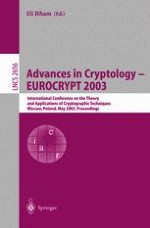2003 | OriginalPaper | Chapter
Two-Threshold Broadcast and Detectable Multi-party Computation
Authors : Matthias Fitzi, Martin Hirt, Thomas Holenstein, Jürg Wullschleger
Published in: Advances in Cryptology — EUROCRYPT 2003
Publisher: Springer Berlin Heidelberg
Included in: Professional Book Archive
Activate our intelligent search to find suitable subject content or patents.
Select sections of text to find matching patents with Artificial Intelligence. powered by
Select sections of text to find additional relevant content using AI-assisted search. powered by
Classical distributed protocols like broadcast or multi-party computation provide security as long as the number of malicious players f is bounded by some given threshold t, i.e., f ≤ t. If f exceeds t then these protocols are completely insecure.We relax this binary concept to the notion of two-threshold security: Such protocols guarantee full security as long as f ≤ t for some small threshold t, and still provide some degraded security when t < f ≤ T for a larger threshold T. In particular, we propose the following problems. Broadcast withExtendedValidity: Standard broadcast is achieved when f ≤ t. When t < f ≤ T, then either broadcast is achieved, or every player learns that there are too many faults. Furthermore, when the sender is honest, then broadcast is always achieved.Broadcast withExtendedConsistency: Standard broadcast is achieved when f ≤ t. When t < f ≤ T, then either broadcast is achieved, or every player learns that there are too many faults. Furthermore, the players agree on whether or not broadcast is achieved.DetectableMulti-PartyComputation: Secure computation is achieved when f ≤ t. When t < f ≤ T, then either the computation is secure, or all players detect that there are too many faults and abort. The above protocols for n players exist if and only if t = 0 or t+2T < n.
